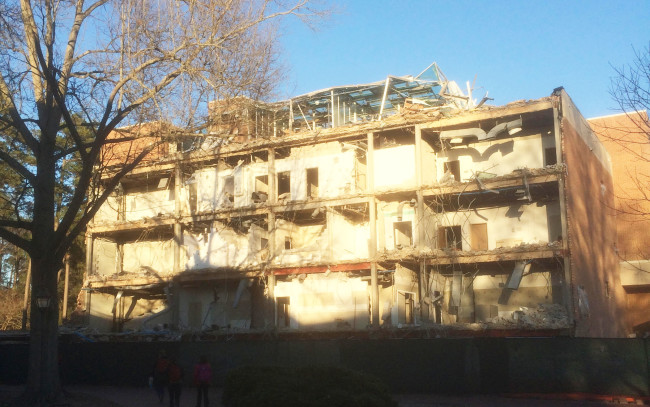The sound of heavy machinery whirred as white smoke drifted across the brick path connecting Sadler to Swem. The thick mesh of steel wires that once held the concrete in place now hung bent and split at odd angles. Rubble fell periodically as the excavator worked on the foundation. Other people lingered, taking in the scene. The demolition of Millington Hall was being completed.
For so long, Millington had blocked Swem Library and its gorgeous east wing, a scenic injustice if ever I saw one.
I was coming back from French class, riding my bike from Landrum, when I saw a view: a beautiful view of new campus. For so long, Millington had blocked Swem Library and its gorgeous east wing, a scenic injustice if ever I saw one. The use of glass and white siding on our library flows perfectly with the modern ISC III also in shot. I realized that this part of campus, that for so long was an eyesore and an inconvenience, had become quite beautiful. The aesthetic now produced was, in my view, thoroughly worth the slight vexation of construction areas. It exemplified a natural continuation of this school’s first and enduring aesthetic: balance and proportion.
I believe the new architectural direction being taken by our school would make our founders proud.
The spacing between Swem, Small and ISC I form three sides of a square centered on the sundial. The inclusion of Millington produced a lopsidedness from which the collective setting suffered. Plans have been made to build another integrated science center, ISC IV, which, in my view, only heightens this balance by evoking our historic architecture on Old Campus. The Wren Building sits in similar relation to the President’s House and the Brafferton, as Swem will sit in relation to Small and ISC IV — both three sides of a square. Nearly 320 years separate the Wren Building’s construction and Millington’s demolition, yet this founding philosophy of balance and proportion can be seen as a common thread between the two. I believe the new architectural direction being taken by our school would make our founders proud.
It is even more reassuring that this aesthetic is being kept in regards to the construction of more science buildings — a discipline that has been viewed as a counter to the more artistic disciplines. The wedding of the two is hopefully symbolic of this institution’s continued insistence on well-rounded education.
What we gain is a lesson from our history, an architectural design that radiates a founding philosophy of balance and proportion.
And so, in the coming weeks, as you pass those construction sites on campus, as you guard your face from the drifting smoke and plug your ears to the sound of heavy machines and the hum of industry, think on all that the construction offers our college. The benefits extend beyond having newer buildings and amenities. What we gain is a lesson from our history, an architectural design that radiates a founding philosophy of balance and proportion.
Email Benjamin Halkowski at bhalkowski@email.wm.edu.

